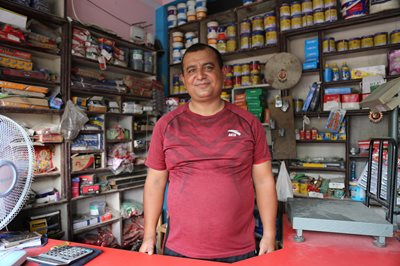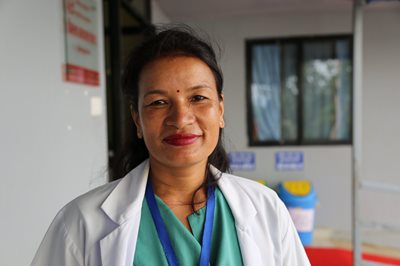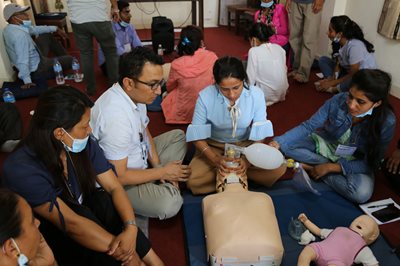By Nathalie Batres
Raju Rayamajhi sits behind the counter in his store animatedly describing the rainy day his 5-year-old son, Shawal, fell from the family’s second storey terrace while playing with friends. “The ball fell off the terrace. The other children came downstairs to catch it, while my son tried to watch it from above. He stepped on a slippery tile. Luckily, he did not fall on the concrete ground, but on the seat of a parked motorbike.”
 Raju Rayamajhi says he is grateful for the enhanced ambulance service provided by the Nepal Red Cross Society. Having a paramedic on board meant his son could get the medical care he needed while on hour-long drive to hospital.
Raju Rayamajhi says he is grateful for the enhanced ambulance service provided by the Nepal Red Cross Society. Having a paramedic on board meant his son could get the medical care he needed while on hour-long drive to hospital.
It was a fall that would be a serious accident in any country, but in rural Nepal where the family lives, quick access to a hospital is hindered by mountainous terrain, often unpaved roads, and the reality of the country’s ambulance system. In most rural areas, the majority of ambulances function more like a taxi with just a driver onboard and no health care professional. As a result, a patient’s health can quickly deteriorate on the long ride to hospital.
Enhancing the ambulance system
Raju had heard about an enhanced ambulance service recently launched in Sindhupalchowk by the Nepal Red Cross Society. The three ambulances, which have been funded by the Canadian Red Cross, include a driver and a paramedic in addition to medical equipment that helps stabilize patients during transport. They are one component of a long term plan to improve access to health care in rural Nepal.
“This ambulance ride felt different because there was a paramedic who knew about medicines and [there were] services on the ambulance too, which made it totally different than other ambulances,” said Raju. “The paramedic services within the ambulance definitely add value. To have a qualified, technical person inside of an ambulance is really great and helpful.”
-min.aspx;.pdf;?width=400&height=266) Dinesh Nepal is a paramedic who treated 5-year-old Shawal after he fell from a two-storey terrace. Dinesh and ambulance driver Chun Bahadur Rana Magar brought the youngster to hospital in an ambulance operated by the Nepal Red Cross Society.
Training first responders
Dinesh Nepal is a paramedic who treated 5-year-old Shawal after he fell from a two-storey terrace. Dinesh and ambulance driver Chun Bahadur Rana Magar brought the youngster to hospital in an ambulance operated by the Nepal Red Cross Society.
Training first responders
Dr Sanu Krishna Shrestha works in Dhulikhel Hospital, a major regional facility about an hour outside of Kathmandu. “In the decade that I have been working at this hospital, we’ve seen many people die on their way to the hospital. They are alive when they travel to the hospital, but on the way, they don’t get any care, and when they reach the hospital they have died,” said Dr Shrestha. Improving the healthcare system was vital. “We have to train people to be first responders in the villages and at the district levels. We have to enhance their knowledge and improve their working environment.”
Dr Shrestha helped develop the Rural Emergency and Trauma Systems Strengthening (RETSS) project with the Canadian Red Cross and Nepal Red Cross. It includes providing emergency and trauma care training to health care providers in rural areas, upgrading ambulance services, and purchasing equipment for rural health posts.
Many rural health care workers had never been trained in CPR or in trauma care. “They were working very hard in their own way, but their [healthcare] knowledge was not updated,” said Dr Shrestha. “This training has improved their knowledge, and services have definitely improved in the rural areas.”
 Sita Shrestha, a nurse in rural Nepal, is one of more than 1,000 healthcare professionals who has received Basic Life Support and Primary Trauma Care training, provided in part by the Canadian Red Cross.
Sita Shrestha, a nurse in rural Nepal, is one of more than 1,000 healthcare professionals who has received Basic Life Support and Primary Trauma Care training, provided in part by the Canadian Red Cross.
 Insert photo of health care training - Caption: Health care professionals participate in Basic Life Support training. Provided in collaboration with the Nepal Red Cross Society and the Ministry of Health, the training aims to improve access to timely health care in rural areas where the majority of citizens live.
Insert photo of health care training - Caption: Health care professionals participate in Basic Life Support training. Provided in collaboration with the Nepal Red Cross Society and the Ministry of Health, the training aims to improve access to timely health care in rural areas where the majority of citizens live.
Sita Shrestha is one of more than 1,000 healthcare professionals who has received the training. A nurse, Sita works at Chautara Hospital in Sindhupalchowk district. Shortly after the training, Sita and her colleagues responded to 32 trauma victims who had come to the hospital after a major traffic accident. “All staff were already trained in Basic Life Support and Primary Trauma Care, so we were able to mobilize a full team. We handled that case very well,” said Sita. “What I learned during my academic years was more theory, and over the years I had forgotten some things I learned. Through this training, which emphasizes hands-on skills practice, I have learned better techniques that are highly useful in my work.”
The key metric for success is the health of patients who experience these improvements in healthcare and ambulance services. “[My son] is good now,” said Raju, after his son returned home from a short hospital stay. “I was very happy with this ambulance service. I’ll share my experience and recommend this ambulance to others as well.”